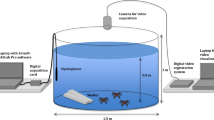Abstract
Mating males of the water strider Gerris remigisproduce vibratory signals when-single males grasp mating pairs. When played through live females with dead males on their backs, these signals repelled mating attempts by single males. A previous study showed that male mate-guarding enhances female foraging effectiveness in this species. Thus male mate-guarding signals also enhance female foraging effectiveness.
Similar content being viewed by others
References
Anderson, N. M. (1982).The Semiaquatic Bugs (Hemiptera, Gerromorpha), Scandinavian Science Press, Kalmpenborg, Denmark.
Arnqvist, G. (1988). Mate guarding and sperm displacement in the water striderGerris lateralis Schumm. (Heteroptera: Gerridae).Freshwater Biol. 19: 269–274.
Arnqvist, G. (1989a). Multiple mating in a water strider: Mutual benefits of intersexual conflict?Anim. Behav. 38: 749–756.
Arnqvist, G. (1989b). Sexual selection in a water strider: the function, mechanism of selection and heritability of a male grasping apparatus.Oikos 56: 344–350.
Clark, S. J. (1987).Prolonged Copulation in the Water Strider Gerris remigisand a Model of the Evolution of Sperm Competition Avoidance Mechanisms, Ph.D. thesis, Rockefeller University. Millbrook, N.Y.
Clark, S. J. (1988). The effects of operational sex ratio and food deprivation on copulation duration in the water strider (Gerris remigis Say).Behav. Ecol. Sociobiol. 23: 317–322.
Firko, M. (1986).Comparative Life History Evolution in the Water Strider, Gerris remigis, Unpublished Ph.D. thesis., University of Pennsylvania, Philadelphia.
Gwynne, D. T., and Morris, G. K. (eds.) (1983).Orthopteran Mating Systems, Westview Press, Boulder, Colo.
Matthey, W. (1975). Observations sur la reproduction deGerris remigis Say. (Hemiptera, Heteroptera).Mitt. Schweiz. Entomol. Ges. 48: 193–198.
McLain, D. K. (1980). Female choice and the adaptive significance of prolonged copulation inNezara viridula (Hemiptera: Pentatomidae).Psyche 87: 325–336.
Parker, G. A. (1974). Courtship persistence and female-guarding as male time-investment strategies.Behaviour 48: 157–184.
Rubenstein, D. I. (1984). Resource acquisition and alternative mating strategies in water striders.Amer. Zool. 24: 45–353.
Rubenstein, D. I. (1989). Sperm competition in the water strider,Gerris remigis.Anim. Behav. 38: 631–636.
Sih, A., Krupa, J., and Travers, S. (1990). An experimental study on the effects of predation risk and feeding regime on the mating behavior of the water strider.Am. Nat. 135: 284–290.
Sillen-Tullberg, B. (1981). Prolonged copulation: A male “postcopulatory” strategy in a promiscuous species.Lygaeus equestris (Heteroptera: Lygaeidae).Behav. Ecol. Sociobiol. 9: 283–289.
Smith, R. L. (1984).Sperm Competition and the Evolution of Animal Mating Systems, Academic Press, Orlando, Fla.
Spence, J. R., and Wilcox, R. S. (1986). The mating systems of two hybridizing species of water striders (Gerridae). II. Alternative tactics of males and females.Behav. Ecol. Sociobiol. 19: 87–95.
Thornhill, R., and Alcock, J. (1983).The Evolution of Insect Mating Systems, Harvard University Press, Cambridge, Mass.
Vepsalainen, K., and Nummelin, M. (1985a). Female territoriality in the waterstridersGerris najas andG. cinereus.Ann. Zool. Fenn. 22: 433–439.
Vepsalainen, K., and Nummelin, M. (1985b). Male territoriality in the waterstriderLimnoporus rufoscutellatus.Ann. Zool. Fenn. 22: 441–448.
Wheelwright, N. T., and Wilkinson, G. S. (1985). Space use by a neotropical water strider (Hemiptera: Gerridae): sex and age-class differences.Biotropica 17:165–169.
Wilcox, R. S. (1979). Sex discrimination inGerris remigis: role of a surface wave signal.Science 206: 1325–1327.
Wilcox, R. S. (1984). Male copulatory guarding enhances female foraging in a water strider.Behav. Ecol. Sociobiol. 15: 171–174.
Wilcox, R. S., and Kashinsky, W. M. (1980). A computerized method of analyzing and playing back vibratory animal signals.Behav. Res. Meth. Instr. 12: 361–363.
Wilcox, R. S., and Ruckdeschel, T. (1982). Food threshold territoriality in a water strider(Gerris remigis). Behav. Ecol. Sociobiol.11: 85–90.
Wilcox, R. S., and Spence, J. R. (1986). The mating systems of two hybridizing species of water striders (Gerridae). I. Ripple signal functions.Behav. Ecol. Sociobiol. 19: 87–95.
Author information
Authors and Affiliations
Rights and permissions
About this article
Cite this article
Stimson Wilcox, R., Di Stefano, J. Vibratory signals enhance mate-guarding in a water strider (Hemiptera: Gerridae). J Insect Behav 4, 43–50 (1991). https://doi.org/10.1007/BF01092550
Accepted:
Issue Date:
DOI: https://doi.org/10.1007/BF01092550




